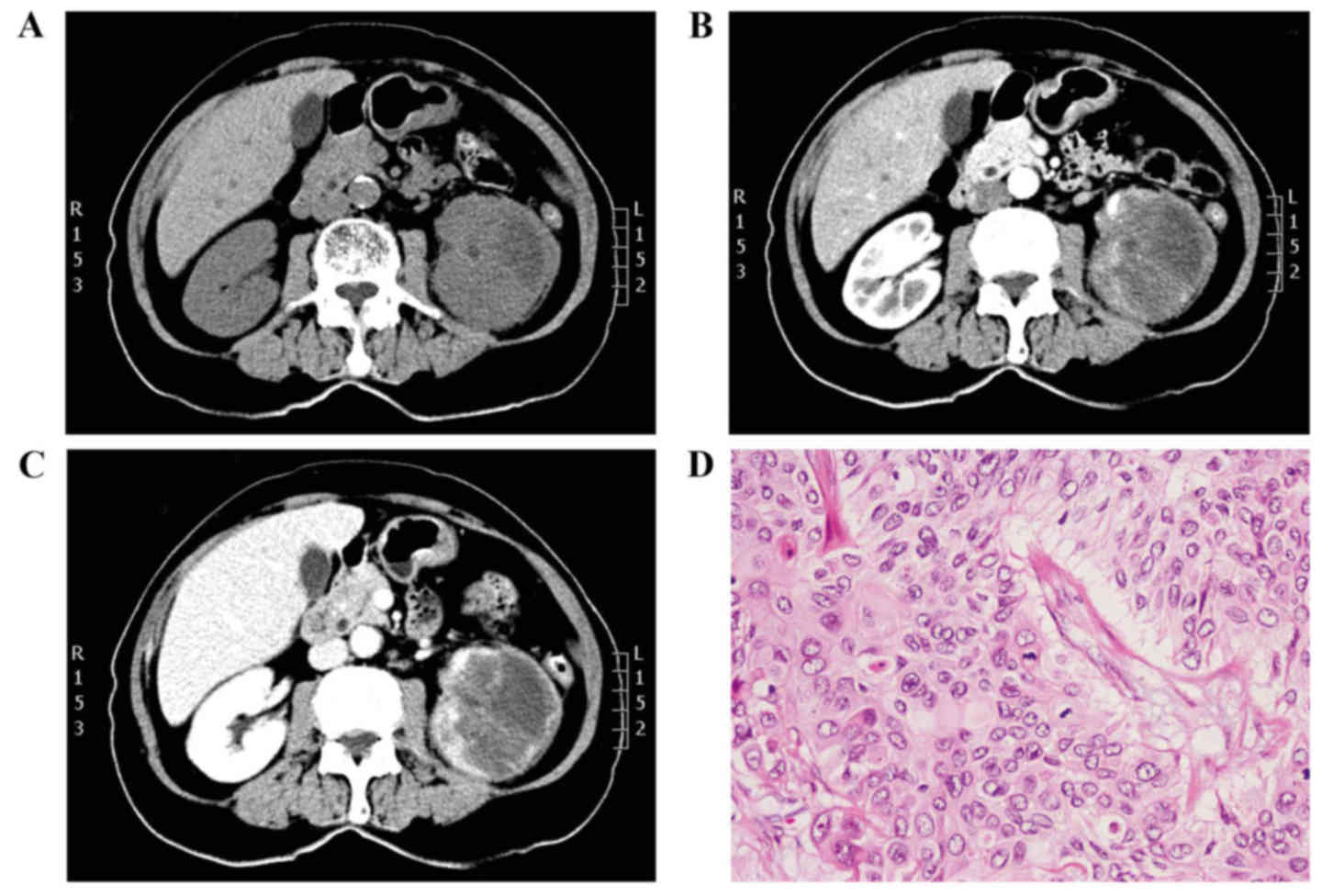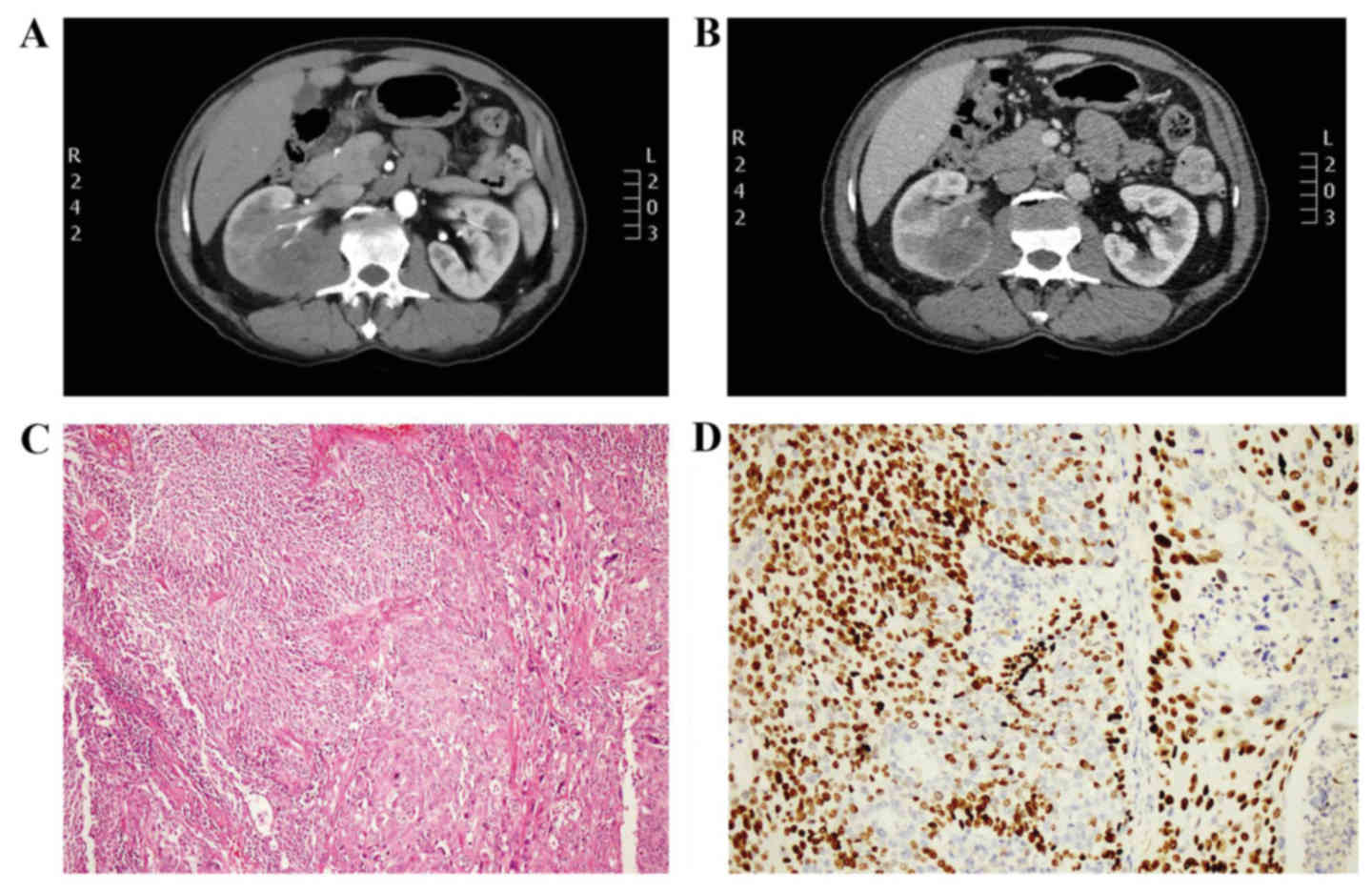|
1
|
Sheir KZ, El-Azab M, Mosbah A, El-Baz M
and Shaaban AA: Differentiation of renal cell carcinoma subtypes by
multislice computerized tomography. J Urol. 174:451–455. 2005.
View Article : Google Scholar : PubMed/NCBI
|
|
2
|
Mandalapu RS and Matin SF: Contemporary
evaluation and management of upper tract urothelial cancer.
Urology. 94:17–23. 2016. View Article : Google Scholar : PubMed/NCBI
|
|
3
|
Arancibia MF, Bolenz C, Michel MS, Keeley
FX Jr and Alken P: The modern management of upper tract urothelial
cancer: Surgical treatment. BJU Int. 99:978–981. 2007. View Article : Google Scholar : PubMed/NCBI
|
|
4
|
Rossi SH, Klatte T, Usher-Smith J and
Stewart GD: Epidemiology and screening for renal cancer. World J
Urol. 2 Apr 2018 (Epub ahead of print).
|
|
5
|
Jaworski D, Szylberg Ł, Gzil A, Stawinski
P, Kasperska A and Marszałek A: Diagnostic difficulties in cases of
papillary urothelial neoplasm of low malignant potential,
urothelial proliferation of uncertain malignant potential,
urothelial dysplasia and urothelial papilloma: A review of current
literature. Ann Diagn Pathol. 17 Dec. 2017, (Epub ahead of print).
View Article : Google Scholar : PubMed/NCBI
|
|
6
|
Czarniecki M, Gautam R, Choyke PL and
Turkbey B: Imaging findings of hereditary renal tumors, a review of
what the radiologist should know. Eur J Radiol. 101:8–16. 2018.
View Article : Google Scholar : PubMed/NCBI
|
|
7
|
Pierorazio PM, Johnson MH, Patel HD, Sozio
SM, Sharma R, Iyoha E, Bass EB and Allaf ME: Management of renal
masses and localized renal cancer: Systematic review and
meta-analysis. J Urol. 196:989–999. 2016. View Article : Google Scholar : PubMed/NCBI
|
|
8
|
Soria F, Shariat SF, Lerner SP, Fritsche
HM, Rink M, Kassouf W, Spiess PE, Lotan Y, Ye D, Fernández MI, et
al: Epidemiology, diagnosis, preoperative evaluation and prognostic
assessment of upper-tract urothelial carcinoma (UTUC). World J
Urol. 35:379–387. 2017. View Article : Google Scholar : PubMed/NCBI
|
|
9
|
Nabi S, Kessler ER, Bernard B, Flaig TW
and Lam ET: Renal cell carcinoma: A review of biology and
pathophysiology. F1000Res. 7:3072018. View Article : Google Scholar : PubMed/NCBI
|
|
10
|
Froemming A, Potretzke T, Takahashi N and
Kim B: Upper tract urothelial cancer. Eur J Radiol. 98:50–60. 2018.
View Article : Google Scholar : PubMed/NCBI
|
|
11
|
Hartman DS, Davidson AJ, Davis CJ Jr and
Goldman SM: Infiltrative renal lesions: CT-sonographic-pathologic
correlation. AJR Am J Roentgenol. 150:1061–1064. 1988. View Article : Google Scholar : PubMed/NCBI
|
|
12
|
Raza SA, Sohaib SA, Sahdev A, Bharwani N,
Heenan S, Verma H and Patel U: Centrally infiltrating renal masses
on CT: differentiating intrarenal transitional cell carcinoma from
centrally located renal cell carcinoma. AJR Am J Roentgenol.
198:846–853. 2012. View Article : Google Scholar : PubMed/NCBI
|
|
13
|
Bata P, Tarnoki DL, Tarnoki AD, Novak PK,
Gyebnar J, Kekesi D, Szendroi A, Fejer B, Szasz AM, Nyirady P, et
al: Transitional cell and clear cell renal carcinoma:
Differentiation of distinct histological types with multiphase CT.
Acta Radiol. 55:1112–1119. 2014. View Article : Google Scholar : PubMed/NCBI
|
|
14
|
Li Y, Ding YU, Chen D, Yu Z, Gui Y, Yang S
and Lai Y: Renal cell carcinoma growing into the renal pelvis and
mimicking transitional cell carcinoma: A case report and literature
review. Oncol Lett. 9:1869–1872. 2015. View Article : Google Scholar : PubMed/NCBI
|
|
15
|
Han JH, Yoon YE, Kim SY, Cho YI, Rha KH,
Choi YD and Han WK: Preoperative lymphocyte-monocyte ratio
ameliorates the accuracy of differential diagnosis in
non-metastatic infiltrative renal masses. Yonsei Med J. 58:388–394.
2017. View Article : Google Scholar : PubMed/NCBI
|
|
16
|
Zhu Q, Zhu W, Wu J and Chen W:
Multidetector CT imaging features of invasive renal parenchyma
urothelial carcinoma. Br J Radiol. 89:201510682016. View Article : Google Scholar : PubMed/NCBI
|
|
17
|
Ginzburg S, Tomaszewski JJ and Kutikov A:
Focal ablation therapy for renal cancer in the era of active
surveillance and minimally invasive partial nephrectomy. Nat Rev
Urol. 14:669–682. 2017. View Article : Google Scholar : PubMed/NCBI
|
|
18
|
Prando A, Prando P and Prando D:
Urothelial cancer of the renal pelvicaliceal system: Unusual
imaging manifestations. Radiographics. 30:1553–1566. 2010.
View Article : Google Scholar : PubMed/NCBI
|
|
19
|
Yoon SK, Nam KJ, Rha SH, Kim JK, Cho KS,
Kim B, Kim KH and Kim KA: Collecting duct carcinoma of the kidney:
CT and pathologic correlation. Eur J Radiol. 57:453–460. 2006.
View Article : Google Scholar : PubMed/NCBI
|
|
20
|
Blitman NM, Berkenblit RG, Rozenblit AM
and Levin TL: Renal medullary carcinoma: CT and MRI features. AJR
Am J Roentgenol. 185:268–272. 2005. View Article : Google Scholar : PubMed/NCBI
|
|
21
|
Yan Y, Liu L, Zhou J, Li L, Li Y, Chen M,
Wang L, He W, Guan X, Zu X and Qi L: Clinicopathologic
characteristics and prognostic factors of sarcomatoid renal cell
carcinoma. J Cancer Res Clin Oncol. 141:345–352. 2015. View Article : Google Scholar : PubMed/NCBI
|
|
22
|
Guarnizo E, Pavlovich CP, Seiba M, Carlson
DL, Vaughan ED Jr and Sosa RE: Ureteroscopic biopsy of upper tract
urothelial carcinoma: Improved diagnostic accuracy and
histopathological considerations using a multi-biopsy approach. J
Urol. 163:52–55. 2000. View Article : Google Scholar : PubMed/NCBI
|
|
23
|
Furukawa J, Miyake H, Sakai I and Fujisawa
M: Significance of ureteroscopic biopsy grade in patients with
upper tract urothelial carcinoma. Curr Urol. 6:156–159. 2013.
View Article : Google Scholar : PubMed/NCBI
|
|
24
|
Huang SY, Ahrar K, Gupta S, Wallace MJ,
Ensor JE, Krishnamurthy S and Matin SF: Safety and diagnostic
accuracy of percutaneous biopsy in upper tract urothelial
carcinoma. BJU Int. 115:625–632. 2015. View Article : Google Scholar : PubMed/NCBI
|











